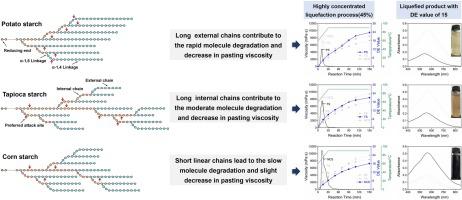Industrial Crops and Products ( IF 5.6 ) Pub Date : 2021-02-26 , DOI: 10.1016/j.indcrop.2021.113347 Haocun Kong , Luxi Yu , Zhengbiao Gu , Zhaofeng Li , Xiaofeng Ban , Li Cheng , Yan Hong , Caiming Li

|
Designing a highly concentrated (45 %, w/w) starch liquefaction process is a green method to enhance the productivity of starch syrup and related fermentation products. Previous studies mainly focused on handling highly concentrated normal corn starch slurries, but the production efficiency and product performance cannot perfectly match the conventional liquefaction process (30 %, w/w). In the present research, four starches from various botanical sources were selected with an objective to accelerate highly concentrated starch liquefaction process. The results demonstrated that with potato starch or tapioca starch as a substrate, liquefaction process was more feasible as observed from the obvious reduction in paste viscosity and acceleration in amylolysis. To clarify the mechanism of these differences, changes in the fine structure during liquefaction were further characterized. The long external chains (16.2 glucose units on average) in potato starch and long internal chains (5.1 glucose units on average) in tapioca starch, which indicated high proportion of consecutive α-1,4 linkages, seemed more susceptible to enzymatic attack under highly concentrated substrate condition. This caused rapid degradation of starch molecules. The liquefied products were suitable for glucose syrup production. By comparison, normal corn starch and waxy corn starch, which contain relatively shorter linear fragments, were less accessible to α-amylase. This suppressed liquefaction process led to the survival of large molecules, thereby being unsuitable for subsequent saccharification process. The results suggest that selecting an appropriate substrate is an effective strategy to accelerate highly concentrated starch liquefaction and improve product performance.
中文翻译:

精细的结构会影响高度浓缩的淀粉液化过程和产品性能
设计高浓度(45%,w / w)的淀粉液化工艺是提高淀粉糖浆和相关发酵产品生产率的绿色方法。先前的研究主要集中在处理高浓度普通玉米淀粉浆料上,但是生产效率和产品性能不能完全匹配常规液化工艺(30%,w / w)。在本研究中,从各种植物来源中选择了四种淀粉,目的是加速高浓度淀粉液化过程。结果表明,以马铃薯淀粉或木薯淀粉为底物,从糊状粘度的明显降低和淀粉分解的加速观察,液化过程是更可行的。为了阐明这些差异的机制,进一步描述了液化过程中细微结构的变化。马铃薯淀粉中的长外链(平均16.2个葡萄糖单位)和木薯淀粉中的长内链(平均5.1个葡萄糖单位),表明连续的α-1,4键的比例很高,在较高的温度下似乎更容易受到酶的攻击。浓缩底物条件。这引起淀粉分子的快速降解。液化产物适合于葡萄糖浆的生产。相比之下,包含相对较短的线性片段的普通玉米淀粉和蜡质玉米淀粉则较难于α-淀粉酶。该抑制的液化过程导致大分子的存活,因此不适合随后的糖化过程。











































 京公网安备 11010802027423号
京公网安备 11010802027423号